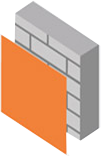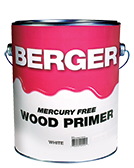Features
See allSurface preparation:
- Surface to be primed must be clean, dry and free from contaminants
- Treat mould, moss or algae with Berger Sterilizing Solution
- Allow to dry thoroughly
- Fill and repair all cracks and joints
- Remove any flaking or blistering paint by chemical, mechanical means
Application Procedure:
- Application by brush, roller or spray
- Stir well before use
- Apply with a brush and work well into the wood grain
- Apply a full coat, allow to dry overnight
- Sand back using #150-180 grit paper
- If necessary re-coat areas that show substrate after sanding
- Clean brushes and equipment with Berger Reducer #2
- Coverage is dependent on texture and porosity of the surface
Tips: When priming, also plan to sand the surface before and also between coats. It helps the primer and topcoats to adhere to the surface better.
Tools you will need
Available Packs

1 Coat
7-9 m2/ ltr**
Coverage
On well-prepared surfaces, as per the painting system recommended. Please refer to the Product Data Sheet for surface preparation and method of application.
** Actual coverage may vary from the quoted coverage due to factors such as method and condition of application, surface roughness, and porosity.
Solve Potential Paint Problems
The scaly pattern on your walls is called Alligatoring; which can be described as a patterned cracking appearance in the paint film, resembling the scales of an alligator.
What are the possible causes?
- Applying a hard, rigid coating, like an oil-based enamel, over a more flexible coating, like a water-based latex primer
- Applying the topcoat before the first coat has dried
- Loss of elasticity in the paint film due to the natural aging of paint
- Failure of the topcoat to bond smoothly with the basecoat
- Applying paint too thickly
- Rate of surface drying is significantly higher than base, in thickly applied paint
What is the solution?
- Remove old paint by scraping, sanding or chemical removal
- Wash with appropriate cleaner and allow surface to dry
- Sand glossy surface to dull finish for application of topcoat
- Ensure surface if sanded to a smooth finish
- Prime before applying premium acrylic paint such as Royale
- Berger recommends Berger Grip & Seal Multi-Surface Primer
We recommend you use these painting systems in order of base coat, first coat, and second coat:
The bubbles or blisters on your walls are caller blistering. Paint blisters or bubbles occur when there is loss of adhesion between the paint film and underlying surface.
What are the possible causes?
- Applying oil-based paint over a damp or wet surface
- Moisture seeping through to the exterior surface from an interior source
- Exposure of latex paint film to moisture shortly after the paint has dried, especially in cases of poor surface preparation
What is the solution?
- If blisters do not go all the way down to the substrate, remove by scraping and sanding
- Repaint with premium Berger topcoat for wood or wall
- For interior wood & wall surfaces, Berger recommends Royale
- Blisters all the way down to the surface are a sign of a more significant source of moisture, which must be addressed before any painting can begin
- Once resolved, remove all loose paint and repair any loose caulking
- Allow surface to dry thoroughly before the application of an appropriate primer and a moisture resistant premium topcoat
We recommend you use these painting systems in order of base coat, first coat, and second coat:
The splitting of dry paint film through at least one coat. In early stages it appears as hairline cracks and in the later stages flaking occurs.
What are the possible causes?
- Applying low quality paint to the surface, with inadequate adhesion and flexibility
- Applying too thin a coat of paint to the surface
- Inadequate surface preparation
- Failure to prime bare wood before top-coating
- Oil paint hardens with age, until it eventually cracks
- Painting on damp wood
What is the solution?
- Remove loose paint or flaking paint by scraping or wire brushing
- Sand the area to feather the edges
- Prime bare spots
- Repaint with two coats of a premium paint
- Berger recommends 2 topcoats over 1 primer coat
We recommend you use these painting systems in order of base coat, first coat, and second coat:
Peeling often occurs when high levels of moisture penetrate the paint film, eventually pushing it away from the surface.
What are the possible causes?
- Excessive atmospheric moisture, e.g. shower
- Excessive moisture due to high humidity, e.g. basement and/or foundation
What is the solution?
- Remove loose paint by scraping or wire-brushing
- Remove any efflorescence and mildew
- Power wash with plain water
- Scrape cracks clean of debris and seal with Berger acrylic caulk
- Remove residual dust particles, taking care to not let water into cracks or porous areas
- Apply premium Berger primer for best durability and resistance
- Always overcoat primer with premium topcoat
We recommend you use these painting systems in order of base coat, first coat, and second coat:
Poor hiding occurs when paint fails to obscure or hide the surface to which it is applied.
What are the possible causes?
- Using low-quality paint with little hiding power
- Spreading paint too thinly or unevenly
- Over-thinning paint beyond the recommended amount
- Failure to prime the surface before top-coating
- Painting a porous or absorbent surface
- Using incorrect or poor quality tools
- Inadequately mixed paint
What is the solution?
- Prime first, if moving from a significantly darker to a light colour
- When painting in a dark colour, tint primer in a similar tone to the topcoat shade
- Use premium quality paint for better hiding and flow
- Use quality and correct tools for the job
- Follow manufacturer's recommendation for thinning
We recommend you use these painting systems in order of base coat, first coat, and second coat:
-
Get Inspiration
-
Make Your Plan

Let us design a project plan to suit your needs.
-
Colour Tools










-can_8696.png?width=82&height=102&mode=crop)





